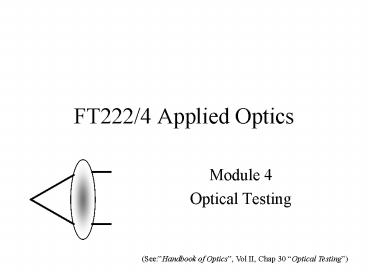FT2224 Applied Optics PowerPoint PPT Presentation
Title: FT2224 Applied Optics
1
FT222/4 Applied Optics
- Module 4
- Optical Testing
(SeeHandbook of Optics, Vol II, Chap 30
Optical Testing)
2
Foucault (Knife Edge) Test
Very sensitive Qualitative test
Examine the image of a point source Knife edge
moved longitudinally through the focus. For a
perfect wavefront shadow of knife will move
smoothly across field of view Any transverse
aberrations detected. Any deviation from a
perfectly spherical wave will be visible as
imperfections in the image.
3
Ronchi Test
Observe a diverging light beam through a coarse
grating of 20-40 lines/cm
Lines will appear straight and parallel only for
a perfectly spherical wavefront.
Distortion from parallel lines is a measure of
aberrations transverse to grating.
4
Hartmann Test
A Hartmann screen with a regular array of holes
is placed close to the optical element
The resultant image is recorded at the optical
system focus
Comparing the resultant image with an ideal
image, accurate information about the surface
shape can be deduced
This technique can be viewed as an experimental
version of ray tracing.
5
Interferometric Testing
Observe the interference between a reference flat
(or spherical) wave and a wave reflected/transmitt
ed through the test element. l/20 accuracy easily
obtained.
See also The Photonics Directory, Book 3 The
Photonics Design and Applications Handbook
(Laurin Publishing)
6
Simple Interferograms
A perfect match of plane (spherical) waves would
give a null (uniform) result.
TILT FOCUS
Very often introduce slight tilt. Varying the
tilt can yield further information about slope
etc.
7
Interferogram Examples
8
Null Testing
(Aspheric) elements can be tested with a null
compensator which should convert a perfect
design wavefront to a planar or spherical
wavefront.
Crucially dependent on fabrication and siting of
the compensator e.g. Hubble
As the compensator is often very difficult to
make accurately, computer generated holograms
(CGHs) that reproduce a perfect design wavefront
are sometimes used.
PowerShow.com is a leading presentation sharing website. It has millions of presentations already uploaded and available with 1,000s more being uploaded by its users every day. Whatever your area of interest, here you’ll be able to find and view presentations you’ll love and possibly download. And, best of all, it is completely free and easy to use.
You might even have a presentation you’d like to share with others. If so, just upload it to PowerShow.com. We’ll convert it to an HTML5 slideshow that includes all the media types you’ve already added: audio, video, music, pictures, animations and transition effects. Then you can share it with your target audience as well as PowerShow.com’s millions of monthly visitors. And, again, it’s all free.
About the Developers
PowerShow.com is brought to you by CrystalGraphics, the award-winning developer and market-leading publisher of rich-media enhancement products for presentations. Our product offerings include millions of PowerPoint templates, diagrams, animated 3D characters and more.

